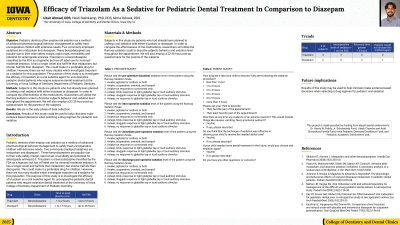Sedation
302 - Efficacy of triazolam as a sedative for pediatric dental treatment in comparison to diazepam

- UA
Uzair Ahmad, DDS (he/him/his)
Resident
University of Iowa, Iowa City, IA
Iowa City, Iowa, United States - NO
Nima Odowa, DDS
University of Iowa
- HS
Heidi Steinkamp, DDS PhD MS
University of Iowa College of Dentistry
Iowa City, Iowa, United States - HS
Heidi Steinkamp, DDS PhD MS
University of Iowa College of Dentistry
Iowa City, Iowa, United States
Presenting Author(s)
Co-Author(s)
Program Director(s)
Purpose: Pediatric dentists often employ oral sedation as a method of advanced pharmacological behavior management to safely treat uncooperative children with extensive needs. Two commonly employed sedatives are midazolam and diazepam. These benzodiazepines are popular due to their wide safety margin, rapid onset, reversibility and potential for anterograde amnesia. Triazolam is a benzodiazepine classified by the FDA as a hypnotic but has off label use for minimal/moderate sedation. It has a longer onset and half-life than midazolam, but shorter half-life than diazepam. This could make it a preferable drug for children. However, there are not many studies which investigate triazolam as a sedative for this population. The purpose of this study is to investigate the efficacy of triazolam as a oral sedative agent for uncooperative pediatric dental patients who require extensive dental treatment at the University of Iowa College of Dentistry Department of Pediatric Dentistry.
Methods: Subjects in this study are patients who had already been planned to undergo oral sedation with either triazolam or diazepam. In order to compare the effectiveness of the medications, researchers will utilize the Ramsey sedation scale to describe subjects behavior and sedation level throughout the appointment. We will also employ a 22-36 hour post-op questionnaire for the parents of the subjects
Results: We are in the early phase of data collection
Conclusion: Results of this study could be used to help clinicians make evidence based decisions when selecting a drug regimen for pediatric oral sedation
Identify Supporting Agency and Grant Number:

.jpg)